Recent Developments and State of the Art in Flexible and Conformal Reconfigurable Antennas
Abstract
:1. Introduction
- Frequency-reconfigurable antenna;
- Pattern-reconfigurable antenna;
- Polarization-reconfigurable antenna;
- Multiple reconfigurable features in an antenna.
2. Frequency-Reconfigurable Antennas
2.1. Antennas Based on Electrical Switches
2.2. Mechanically Frequency-Reconfigurable Antennas
2.2.1. Microfluidic Antennas
2.2.2. Antennas Based on Metallic Micromesh
2.2.3. Kirigami and Origami-Based Antennas
2.3. Antennas at Millimetre-Wave
3. Pattern-Reconfigurable Antennas
3.1. Pattern-Reconfigurable Antennas Based-On Electircal Switches
3.2. Mechanically Pattern-Reconfigurable Antennas
3.3. Dual Mode Antennas
4. Polarization-Reconfigurable Antennas
5. Multiple Reconfigurable Features in Antennas
- Frequency and polarization;
- Frequency and pattern.
5.1. Frequency and Polarization Reconfigurability
5.2. Frequency and Pattern Reconfigurability
6. Comparison between Proposed Techniques for Flexible Reconfigurable Antennas
7. Conclusions
- Characterization of new flexible materials with low-moderate loss at mm-wave and terahertz frequencies;
- Robust integration methods to combine switching elements with flexible materials;
- Development if switch-less reconfiguration approaches;
- Integrating MEMS switches on flexible materials to realize this type of antenna;
- Integrating optical switches on flexible materials to realize this type of antenna;
- Employing reconfigurable microfluidic antennas for complex patch structures.
Author Contributions
Funding
Acknowledgments
Conflicts of Interest
References
- Salleh, S.M.; Jusoh, M.; Ismail, A.H.; Kamarudin, M.R.; Nobles, P.; Rahim, M.K.A.; Sabapathy, T.; Osman, M.N.; Jais, M.I.; Soh, P.J. Textile antenna with simultaneous frequency and polarization reconfiguration for WBAN. IEEE Access 2018, 6, 7350–7358. [Google Scholar] [CrossRef]
- Haider, N.; Caratelli, D.; Yarovoy, A. Recent developments in reconfigurable and multiband antenna technology. Int. J. Antennas Propag. 2013, 2013, 869170. [Google Scholar] [CrossRef] [Green Version]
- Sayem, A.S.M.; Simorangkir, R.B.V.B.; Esselle, K.P.; Hashmi, R.M.; Liu, H. A Method to Develop Flexible Robust Optically Transparent Unidirectional Antennas Utilizing Pure Water, PDMS and Transparent Conductive Mesh. IEEE Trans. Antennas Propag. 2020. [Google Scholar] [CrossRef]
- Sayem, A.S.M.; Simorangkir, R.B.V.B.; Esselle, K.P.; Hashmi, R.M. Development of Robust Transparent Conformal Antennas Based on Conductive Mesh-Polymer Composite for Unobtrusive Wearable Applications. IEEE Trans. Antennas Propag. 2019, 67, 7216–7224. [Google Scholar] [CrossRef]
- Anagnostou, D.; Iskander, M. Adaptive Flexible Antenna Array System for Deformable Wing Surfaces. In Proceedings of the 2015 IEEE Aerospace Conference, Big Sky, MT, USA, 7–14 March 2015; pp. 1–6. [Google Scholar]
- Anagnostou, D.E. Flexible arrays signal change in communications. Nat. Electron. 2019, 2, 180–181. [Google Scholar] [CrossRef]
- Varnoosfaderani, M.V.; Thiel, D.V.; Lu, J. External parasitic elements on clothing for improved performance of wearable antennas. IEEE Sens. J. 2014, 15, 307–315. [Google Scholar] [CrossRef]
- Varnoosfaderani, M.V.; Thiel, D.V.; Lu, J.W. A wideband slot antenna in a box for wearable sensor nodes. IEEE Antennas Wirel. Propag. Lett. 2015, 14, 1494–1497. [Google Scholar] [CrossRef]
- Parchin, N.O.; Basherlou, H.J.; Al-Yasir, Y.I.; Abdulkhaleq, A.M.; Abd-Alhameed, R.A. Reconfigurable antennas: Switching techniques—A survey. Electronics 2020, 9, 336. [Google Scholar] [CrossRef] [Green Version]
- Motovilova, E.; Huang, S.Y. A review on reconfigurable liquid dielectric antennas. Materials 2020, 13, 1863. [Google Scholar] [CrossRef]
- Rutschlin, V.; Sokol, V. Reconfigurable antenna simulation. IEEE Microw. Mag. 2013, 14, 92–101. [Google Scholar] [CrossRef]
- Oliveri, G.; Werner, D.H.; Massa, A. Reconfigurable electromagnetics through metamaterials—A review. Proc. IEEE 2015, 103, 1034–1056. [Google Scholar] [CrossRef] [Green Version]
- Petosa, A. An overview of tuning techniques for frequency-agile antennas. IEEE Antennas Propag. Mag. 2012, 54, 271–296. [Google Scholar] [CrossRef]
- Parchin, N.O.; Basherlou, H.J.; Al-Yasir, Y.I.; Abd-Alhameed, R.A.; Abdulkhaleq, A.M.; Noras, J.M. Recent developments of reconfigurable antennas for current and future wireless communication systems. Electronics 2019, 8, 128. [Google Scholar] [CrossRef] [Green Version]
- Christodoulou, C.G.; Tawk, Y.; Lane, S.A.; Erwin, S.R. Reconfigurable antennas for wireless and space applications. Proc. IEEE 2012, 100, 2250–2261. [Google Scholar] [CrossRef]
- Haupt, R.L.; Lanagan, M. Reconfigurable antennas. IEEE Antennas Propag. Mag. 2013, 55, 49–61. [Google Scholar] [CrossRef]
- Kumar, J.; Basu, B.; Talukdar, F.A.; Nandi, A. Graphene-based multimode inspired frequency reconfigurable user terminal antenna for satellite communication. IET Commun. 2017, 12, 67–74. [Google Scholar] [CrossRef]
- Javed, A.; Bhellar, B.; Tahir, F.A. Reconfigurable Body Worn Antenna for Bluetooth and WiMAX. In Proceedings of the 12th International Bhurban Conference on Applied Sciences and Technology (IBCAST), Islamabad, Pakistan, 13–17 January 2015; pp. 571–573. [Google Scholar]
- Khan, M.; Shah, S.; Ullah, S. Dual-Band Frequency Reconfigurable Microstrip Patch Antenna on Wearable Substrate for WiFi and WiMAX Applications; Technical Journal; University of Engineering and Technology: Taxila, Pakistan, 2017; Volume 22, pp. 35–40. [Google Scholar]
- Tahir, F.A.; Javed, A. A compact dual-band frequency reconfigurable textile antenna for wearable applications. Microw. Opt. Technol. Lett. 2015, 57, 2251–2257. [Google Scholar] [CrossRef]
- Saraswat, K.; Harish, A.R. Flexible dual-band dual-polarised CPW-fed monopole antenna with discrete-frequency reconfigurability. IET Microw. Antennas Propag. 2019, 13, 2053–2060. [Google Scholar] [CrossRef]
- Saeed, S.M.; Balanis, C.A.; Birtcher, C.R. Inkjet-printed flexible reconfigurable antenna for conformal WLAN/WiMAX wireless devices. IEEE Antennas Wirel. Propag. Lett. 2016, 15, 1979–1982. [Google Scholar] [CrossRef]
- Sabapathy, T.; Bashah, M.; Jusoh, M.; Soh, P.; Kamarudin, M. Frequency Reconfigurable Rectangular Antenna with T-Slotted Feed Line. In Proceedings of the 2016 International Conference on Radar, Antenna, Microwave, Electronics, and Telecommunications (ICRAMET), Jakarta, Indonesia, 3–5 October 2016; pp. 81–84. [Google Scholar]
- Simorangkir, R.B.; Yang, Y.; Esselle, K.P.; Zeb, B.A. A method to realize robust flexible electronically tunable antennas using polymer-embedded conductive fabric. IEEE Trans. Antennas Propag. 2017, 66, 50–58. [Google Scholar] [CrossRef]
- Chen, S.J.; Ranasinghe, D.C.; Fumeaux, C. A robust Snap-On button solution for reconfigurable wearable textile antennas. IEEE Trans. Antennas Propag. 2018, 66, 4541–4551. [Google Scholar] [CrossRef]
- Kasirga, T.S.; Ertas, Y.N.; Bayindir, M. Microfluidics for reconfigurable electromagnetic metamaterials. Appl. Phys. Lett. 2009, 95, 214102. [Google Scholar] [CrossRef]
- King, A.J.; Patrick, J.F.; Sottos, N.R.; White, S.R.; Huff, G.H.; Bernhard, J.T. Microfluidically switched frequency reconfigurable slot antennas. IEEE Antennas Wirel. Propag. Lett. 2013, 12, 828–831. [Google Scholar] [CrossRef]
- Murray, C.; Franklin, R.R. Frequency Tunable Fluidic Annular Slot Antenna. In Proceedings of the 2013 IEEE Antennas and Propagation Society International Symposium (APSURSI), Orlando, FL, USA, 7–13 July 2013; pp. 386–387. [Google Scholar]
- Murray, C.; Franklin, R.R. Independently tunable annular slot antenna resonant frequencies using fluids. IEEE Antennas Wirel. Propag. Lett. 2014, 13, 1449–1452. [Google Scholar] [CrossRef]
- Chaudhari, S.; Alharbi, S.; Zou, C.; Shah, H.; Harne, R.L.; Kiourti, A. A New Class of Reconfigurable Origami Antennas Based on E-Textile Embroidery. In Proceedings of the 2018 IEEE International Symposium on Antennas and Propagation & USNC/URSI National Radio Science Meeting, Boston, MA, USA, 8–13 July 2018; pp. 183–184. [Google Scholar]
- Liu, X.; Yao, S.; Cook, B.S.; Tentzeris, M.M.; Georgakopoulos, S.V. An origami reconfigurable axial-mode bifilar helical antenna. IEEE Trans. Antennas Propag. 2015, 63, 5897–5903. [Google Scholar] [CrossRef]
- Hayes, G.J.; Liu, Y.; Genzer, J.; Lazzi, G.; Dickey, M.D. Self-folding origami microstrip antennas. IEEE Trans. Antennas Propag. 2014, 62, 5416–5419. [Google Scholar] [CrossRef]
- Yao, S.; Liu, X.; Georgakopoulos, S.V. Morphing origami conical spiral antenna based on the Nojima wrap. IEEE Trans. Antennas Propag. 2017, 65, 2222–2232. [Google Scholar] [CrossRef]
- Mazlouman, S.J.; Mahanfar, A.; Menon, C.; Vaughan, R.G. Reconfigurable axial-mode helix antennas using shape memory alloys. IEEE Trans. Antennas Propag. 2011, 59, 1070–1077. [Google Scholar] [CrossRef]
- Liu, X.; Yao, S.; Georgakopoulos, S.V. A Frequency Tunable Origami Spherical Helical Antenna. In Proceedings of the 2017 IEEE International Symposium on Antennas and Propagation & USNC/URSI National Radio Science Meeting, San Diego, CA, USA, 9–14 July 2017; pp. 1361–1362. [Google Scholar]
- Yao, S.; Liu, X.; Gibson, J.; Georgakopoulos, S.V. Deployable Origami Yagi Loop Antenna. In Proceedings of the 2015 IEEE International Symposium on Antennas and Propagation & USNC/URSI National Radio Science Meeting, Vancouver, BC, Canada, 19–24 July 2015; pp. 2215–2216. [Google Scholar]
- Alharbi, S.; Chaudhari, S.; Inshaar, A.; Shah, H.; Zou, C.; Harne, R.L.; Kiourti, A. E-textile origami dipole antennas with graded embroidery for adaptive RF performance. IEEE Antennas Wirel. Propag. Lett. 2018, 17, 2218–2222. [Google Scholar] [CrossRef]
- Lee, S.; Shah, S.I.H.; Lee, H.L.; Lim, S. Frequency reconfigurable antenna inspired by origami flasher. IEEE Antennas Wirel. Propag. Lett. 2019, 18, 1691–1695. [Google Scholar] [CrossRef]
- Khan, M.R.; Zekios, C.L.; Bhardwaj, S.; Georgakopoulos, S.V. Origami-Enabled Frequency Reconfigurable Dipole Antenna. In Proceedings of the 2019 IEEE International Symposium on Antennas and Propagation and USNC-URSI Radio Science Meeting, Atlanta, GA, USA, 7–12 July 2019; pp. 901–902. [Google Scholar]
- Shah, S.I.H.; Lim, S. Frequency switchable origami magic cube antenna. In Proceedings of the 2017 IEEE Asia Pacific Microwave Conference (APMC), Kuala Lumpar, Malaysia, 13–16 November 2017; pp. 105–107. [Google Scholar]
- Zainud-Deen, S.H.; Malhat, H.A.E.-A.; El-Shalaby, N.A.A.S.; Gaber, S.M. Circular polarization bandwidth reconfigurable high gain planar plasma helical antenna. IEEE Trans. Plasma Sci. 2019, 47, 4274–4280. [Google Scholar] [CrossRef]
- Liu, X.; Yao, S.; Georgakopoulos, S.V.; Tentzeris, M. Origami Quadrifilar Helix Antenna in UHF Band. In Proceedings of the 2014 IEEE Antennas and Propagation Society International Symposium (APSURSI), Memphis, TN, USA, 6–11 July 2014; pp. 372–373. [Google Scholar]
- Liu, X.; Georgakopoulos, S.V.; Tentzeris, M. A Novel Mode and Frequency Reconfigurable Origami Quadrifilar Helical Antenna. In Proceedings of the 2015 IEEE 16th Annual Wireless and Microwave Technology Conference (WAMICON), Cocoa Beach, FL, USA, 13–15 April 2015; pp. 1–3. [Google Scholar]
- Liu, X.; Yao, S.; Georgakopoulos, S.V. Frequency Reconfigurable Origami Quadrifilar Helical Antenna with Reconfigurable Reflector. In Proceedings of the 2015 IEEE International Symposium on Antennas and Propagation & USNC/URSI National Radio Science Meeting, Vancouver, BC, Canada, 19–24 July 2015; pp. 2217–2218. [Google Scholar]
- Liu, X.; Yao, S.; Gonzalez, P.; Georgakopoulos, S.V. A Novel Ultra-Wideband Origami Reconfigurable Quasi-Taper Helical Antenna. In Proceedings of the 2016 IEEE International Symposium on Antennas and Propagation (APSURSI), Fajardo, Puerto Rico, 26 June–1 July 2016; pp. 839–840. [Google Scholar]
- Liu, X.; Yao, S.; Russo, N.; Georgakopoulos, S.V. Reconfigurable helical antenna based on origami neoprene with high radiation efficiency. In Proceedings of the 2018 IEEE International Symposium on Antennas and Propagation & USNC/URSI National Radio Science Meeting, Boston, MA, USA, 8–13 July 2018; pp. 185–186. [Google Scholar]
- Liu, X.; Yao, S.; Russo, N.; Georgakopoulos, S. Tri-band Reconfigurable Origami Helical Array. In Proceedings of the 2018 IEEE International Symposium on Antennas and Propagation & USNC/URSI National Radio Science Meeting, Boston, MA, USA, 8–13 July 2018; pp. 1231–1232. [Google Scholar]
- Carrara, G.P.; Russo, N.E.; Zekios, C.L.; Georgakopoulos, S.V. A Deployable and Reconfigurable Origami Antenna for extended Mobile Range. In Proceedings of the 2019 IEEE International Symposium on Antennas and Propagation and USNC-URSI Radio Science Meeting, Atlanta, GA, USA, 7–12 July 2019; pp. 453–454. [Google Scholar]
- Liu, X.; Yao, S.; Georgakopoulos, S.V.; Cook, B.S.; Tentzeris, M.M. Reconfigurable Helical Antenna Based on an Origami Structure for Wireless communication system. In Proceedings of the 2014 IEEE MTT-S International Microwave Symposium (IMS2014), Tampa, FL, USA, 1–6 June 2014; pp. 1–4. [Google Scholar]
- Yao, S.; Bao, K.; Liu, X.; Georgakopoulos, S.V. Tunable UHF Origami Spring Antenna with Actuation System. In Proceedings of the 2017 IEEE International Symposium on Antennas and Propagation & USNC/URSI National Radio Science Meeting, San Diego, CA, USA, 9–14 July 2017; pp. 325–326. [Google Scholar]
- Yao, S.; Georgakopoulos, S.V.; Cook, B.; Tentzeris, M. A Novel Reconfigurable Origami Accordion Antenna. In Proceedings of the 2014 IEEE MTT-S International Microwave Symposium (IMS2014), Tampa, FL, USA, 1–6 June 2014; pp. 1–4. [Google Scholar]
- Cardoso, J.; Safaai-Jazi, A. Spherical helical antenna with circular polarisation over a broad beam. Electron. Lett. 1993, 29, 325–326. [Google Scholar] [CrossRef]
- Seiler, S.R.; Bazzan, G.; Fuchi, K.; Alanyak, E.J.; Gillman, A.S.; Reich, G.W.; Buskohl, P.R.; Pallampati, S.; Sessions, D.; Grayson, D.; et al. Physical Reconfiguration of an origami-inspired deployable Microstrip Patch Antenna Array. In Proceedings of the 2017 IEEE International Symposium on Antennas and Propagation & USNC/URSI National Radio Science Meeting, San Diego, CA, USA, 9–14 July 2017; pp. 2359–2360. [Google Scholar]
- Saeed, S.M.; Balanis, C.A.; Birtcher, C.R.; Durgun, A.C.; Shaman, H.N. Wearable flexible reconfigurable antenna integrated with artificial magnetic conductor. IEEE Antennas Wirel. Propag. Lett. 2017, 16, 2396–2399. [Google Scholar] [CrossRef]
- Mohamadzade, B.; Hashmi, R.M.; Simorangkir, R.B.; Gharaei, R.; Rehman, S.U.; Abbasi, Q.H. Recent advances in fabrication methods for flexible antennas in wearable devices: State of the art. Sensors 2019, 19, 2312. [Google Scholar] [CrossRef] [Green Version]
- Mohamadzade, B.; Simorangkir, R.B.; Hashmi, R.M.; Lalbakhsh, A. A conformal ultrawideband antenna with monopole-like radiation patterns. IEEE Trans. Antennas Propag. 2020, 68, 6383–6388. [Google Scholar] [CrossRef]
- Mohamadzade, B.; Simorangkir, R.B.; Hashmi, R.M.; ChaoOger, Y.; Zhadobov, M.; Sauleau, R. A conformal band-notched ultrawideband antenna with monopole-like radiation characteristics. IEEE Antennas Wirel. Propag. Lett. 2019, 19, 203–207. [Google Scholar] [CrossRef]
- Shakhirul, M.; Jusoh, M.; Ismail, A.; Kamarudin, M.; Rahim, H.A.; Sabapathy, T. Reconfigurable Frequency with Circular Polarization for on-Body Wearable Textile Antenna. In Proceedings of the 2016 10th European Conference on Antennas and Propagation (EuCAP), Davos, Switzerland, 10–15 April 2016; pp. 1–4. [Google Scholar]
- Dang, Q.H.; Chen, S.J.; Ranasinghe, D.C.; Fumeaux, C. A Reconfiguration Module with Coplanar Snap-On Connection for Wearable Textile Antennas. In Proceedings of the 2019 IEEE Asia-Pacific Microwave Conference (APMC), Singapore, Singapore, 10–13 December 2019; pp. 613–615. [Google Scholar]
- Kingsley, N.; Anagnostou, D.E.; Tentzeris, M.; Papapolymerou, J. RF MEMS sequentially reconfigurable Sierpinski antenna on a flexible organic substrate with novel dc-biasing technique. J. Microelectromechan. Syst. 2007, 16, 1185–1192. [Google Scholar] [CrossRef]
- Bairavasubramanian, R.; Kingsley, N.; DeJean, G.; Wang, G.; Anagnostou, D.E.; Tentzeris, M.; Papapolymerou, J. Recent Developments on Lightweight, Flexible, Dual Polarization/Frequency Phased Arrays Using RF Mems Switches on LCP Multilayer Substrates for Remote Sensing of Precipitation. In Proceedings of the 6th Annual NASA Earth Science Technology Conference (ESTC 2006), College Park, MD, USA, 27–29 June 2006. [Google Scholar]
- Anagnostou, D.E.; Bairavasubramanian, R.; DeJean, G.; Wang, G.; Kingsley, N.; Tentzeris, M.; Papapolymerou, J. Development of a Dual-Frequency, Dual-Polarization, Flexible and Deployable Antenna Array for Weather Applications. In Proceedings of the 15th IST Mobile & Wireless Communication Summit, Myconos, Greece, 4–8 June 2006. [Google Scholar]
- Jang, T.; Zhang, C.; Youn, H.; Zhou, J.; Guo, L.J. Semitransparent and flexible mechanically reconfigurable electrically small antennas based on tortuous metallic micromesh. IEEE Trans. Antennas Propag. 2016, 65, 150–158. [Google Scholar] [CrossRef]
- Saghati, A.P.; Batra, J.S.; Kameoka, J.; Entesari, K. Miniature and reconfigurable CPW folded slot antennas employing liquid-metal capacitive loading. IEEE Trans. Antennas Propag. 2015, 63, 3798–3807. [Google Scholar] [CrossRef]
- Saghati, A.P.; Batra, J.; Kameoka, J.; Entesari, K. A Microfluidically-Switched CPW Folded Slot Antenna. In Proceedings of the 2014 IEEE Antennas and Propagation Society International Symposium (APSURSI), Memphis, TN, USA, 6–11 July 2014; pp. 557–558. [Google Scholar]
- So, J.-H.; Thelen, J.; Qusba, A.; Hayes, G.J.; Lazzi, G.; Dickey, M.D. Reversibly deformable and mechanically tunable fluidic antennas. Adv. Funct. Mater. 2009, 19, 3632–3637. [Google Scholar] [CrossRef]
- Mazlouman, S.J.; Jiang, X.J.; Mahanfar, A.; Menon, C.; Vaughan, R.G. A Reconfigurable Patch Antenna Using Liquid Metal Embedded in a Silicone Substrate. IEEE Trans. Antennas Propag. 2011, 59, 4406–4412. [Google Scholar] [CrossRef]
- Zandvakili, M.; Honari, M.M.; Sameoto, D.; Mousavi, P. Microfluidic Liquid Metal Based Mechanically Reconfigurable Antenna Using Reversible Gecko Adhesive Based Bonding. In Proceedings of the 2016 IEEE MTT-S International Microwave Symposium (IMS), San Francisco, CA, USA, 22–27 May 2016; pp. 1–4. [Google Scholar]
- Su, W.; Nauroze, S.A.; Ryan, B.; Tentzeris, M.M. Novel 3d Printed Liquid-Metal-Alloy Microfluidics-Based Zigzag and Helical Antennas for Origami Reconfigurable Antenna “Trees”. In Proceedings of the 2017 IEEE MTT-S International Microwave Symposium (IMS), Honololu, HI, USA, 4–9 June 2017; pp. 1579–1582. [Google Scholar]
- Georgakopoulos, S.V. Reconfigurable Origami Antennas. In Proceedings of the 2019 International Applied Computational Electromagnetics Society Symposium (ACES), Miami, FL, USA, 14–19 April 2019; pp. 1–2. [Google Scholar]
- Fuchi, K.; Buskohl, P.R.; Joo, J.J.; Reich, G.W.; Vaia, R.A. Resonance Tuning of RF Devices through Origami Folding. In Proceedings of the 20th International Conference on Composite Materials, Copenhagen, Denmark, 19–24 July 2015; pp. 1–10. [Google Scholar]
- Liu, X.; Georgakopoulos, S.V.; Rao, S. A design of an origami reconfigurable QHA with a foldable reflector [antenna applications corner]. IEEE Antennas Propag. Mag. 2017, 59, 78–105. [Google Scholar] [CrossRef]
- Liu, X.; Zekios, C.L.; Georgakopoulos, S.V. Analysis of a packable and tunable origami multi-radii helical antenna. IEEE Access 2019, 7, 13003–13014. [Google Scholar] [CrossRef]
- Shah, S.I.H.; Lim, S. A dual band frequency reconfigurable origami magic cube antenna for wireless sensor network applications. Sensors 2017, 17, 2675. [Google Scholar] [CrossRef] [Green Version]
- Liu, C.-X.; Zhang, Y.-J.; Li, Y. Precisely manipulated origami for consecutive frequency reconfigurable antennas. Smart Mater. Struct. 2019, 28, 095020. [Google Scholar] [CrossRef]
- Lee, S.; Lee, M.; Lim, S. Frequency reconfigurable antenna actuated by three-storey tower kirigami. Extrem. Mech. Lett. 2020, 39, 100833. [Google Scholar] [CrossRef]
- Nogi, M.; Komoda, N.; Otsuka, K.; Suganuma, K. Foldable nanopaper antennas for origami electronics. Nanoscale 2013, 5, 4395–4399. [Google Scholar] [CrossRef]
- Jilani, S.F.; Rahimian, A.; Alfadhl, Y.; Alomainy, A. Low-profile flexible frequency-reconfigurable millimetre-wave antenna for 5G applications. Flex. Print. Electron. 2018, 3, 035003. [Google Scholar] [CrossRef]
- Jilani, S.F.; Greinke, B.; Hao, Y.; Alomainy, A. Flexible Millimetre-Wave Frequency Reconfigurable Antenna for Wearable Applications in 5G Networks. In Proceedings of the 2016 URSI International Symposium on Electromagnetic Theory (EMTS), Espoo, Finland, 14–18 August 2016; pp. 846–848. [Google Scholar]
- Radha, S.; Rao, P.H. Pattern Reconfigurable Ultra Wideband Thin Antenna. In Proceedings of the 2012 Third International Conference on Computing, Communication and Networking Technologies (ICCCNT’12), Coimbatore, India, 26–28 July 2012; pp. 1–5. [Google Scholar]
- Jais, M.; Jamlos, M.; Jusoh, M.; Sabapathy, T.; Kamarudin, M. 2.45 GHz Beam-Steering Textile Antenna for WBAN Application. In Proceedings of the 2013 IEEE Antennas and Propagation Society International Symposium (APSURSI), Orlando, FL, USA, 7–13 July 2013; pp. 200–201. [Google Scholar]
- He, X.; Gao, P.; Zhu, Z.; You, S.; Wang, P. A flexible pattern reconfigurable antenna for WLAN wireless systems. J. Electromagn. Waves Appl. 2019, 33, 782–793. [Google Scholar] [CrossRef]
- Mohamadzade, B.; Simorangkir, R.B.; Hashmi, R.M.; Shrestha, S. Low-Profile Pattern Reconfigurable Antenna for Wireless Body Area Networks. In Proceedings of the 2019 International Conference on Electromagnetics in Advanced Applications (ICEAA), Granada, Spain, 9–13 September 2019; pp. 546–547. [Google Scholar]
- Mohamadzade, B.; Simorangkir, R.B.; Hashmi, R.M.; Gharaei, R.; Lalbakhsh, A. Monopole-like and semi-directional reconfigurable pattern antenna for wireless body area network applications. Microw. Opt. Technol. Lett. 2019, 61, 2760–2765. [Google Scholar] [CrossRef]
- Ha, S.-J.; Jung, Y.-B.; Kim, Y.; Jung, C.W. Reconfigurable beam-steering antenna using dipole and loop combined structure for wearable applications. ETRI J. 2012, 34, 1–8. [Google Scholar] [CrossRef]
- Yan, S.; Vandenbosch, G.A. Radiation pattern-reconfigurable wearable antenna based on metamaterial structure. IEEE Antennas Wirel. Propag. Lett. 2016, 15, 1715–1718. [Google Scholar] [CrossRef]
- Yan, S.; Vandenbosch, G.A. Wearable Pattern Reconfigurable Patch Antenna. In Proceedings of the 2016 IEEE International Symposium on Antennas and Propagation (APSURSI), Puerto Rico, USA, 26 June–1 July 2016; pp. 1665–1666. [Google Scholar]
- Mendes, C.; Peixeiro, C. A dual-mode single-band wearable microstrip antenna for body area networks. IEEE Antennas Wirel. Propag. Lett. 2017, 16, 3055–3058. [Google Scholar] [CrossRef]
- Di Natale, A.; Di Giampaolo, E. A reconfigurable all-textile wearable UWB antenna. Prog. Electromagn. Res. 2020, 103, 31–43. [Google Scholar] [CrossRef]
- Moghadas, H.; Zandvakili, M.; Sameoto, D.; Mousavi, P. Beam reconfigurable aperture antenna by stretching or reshaping of a flexible surface. IEEE Antennas Wirel. Propag. Lett. 2016, 16, 1337–1340. [Google Scholar] [CrossRef]
- Shah, S.I.H.; Ghosh, S.; Lim, S. A Novel Bio Inspired Pattern Reconfigurable Quasi-Yagi Helical Antenna using Origami DNA. In Proceedings of the 2018 International Symposium on Antennas and Propagation (ISAP), Busan, Korea, 23–26 October 2018. [Google Scholar]
- Shah, S.I.H.; Lim, S. Thermally beam-direction-and beamwidth switchable monopole antenna using origami reflectors with smart shape memory polymer hinges. IEEE Antennas Wirel. Propag. Lett. 2019, 18, 1696–1700. [Google Scholar] [CrossRef]
- Shah, S.I.H.; Tentzeris, M.M.; Lim, S. A deployable quasiyagi monopole antenna using three origami magic spiral cubes. IEEE Antennas Wirel. Propag. Lett. 2018, 18, 147–151. [Google Scholar] [CrossRef]
- Hatsopoulos, N.G.; Warren, W.H., Jr. Resonance tuning in rhythmic arm movements. J. Mot. Behav. 1996, 28, 3–14. [Google Scholar] [CrossRef]
- Xu, Y.; Kim, Y.; Tentzeris, M.M.; Lim, S. Bi-directional loop antenna array using magic cube origami. Sensors 2019, 19, 3911. [Google Scholar] [CrossRef] [Green Version]
- Jais, M.I.; Jamlos, M.; Jusoh, M.; Sabapathy, T.; Kamarudin, M.R. A novel 1.575-GHz dual-polarization textile antenna for gps application. Microw. Opt. Technol. Lett. 2013, 55, 2414–2420. [Google Scholar] [CrossRef]
- Lee, C.M.; Jung, C.W. Radiation-pattern-reconfigurable antenna using monopole-loop for Fitbit flex wristband. IEEE Antennas Wirel. Propag. Lett. 2014, 14, 269–272. [Google Scholar] [CrossRef]
- Liu, X.; Yao, S.; Georgakopoulos, S.V. Mode Reconfigurable Bistable Spiral Antenna Based on Kresling Origami. In Proceedings of the 2017 IEEE International Symposium on Antennas and Propagation & USNC/URSI National Radio Science Meeting, San Diego, CA, USA, 9–14 July 2017; pp. 413–414. [Google Scholar]
- Bhattacharjee, S.; Teja, S.; Midya, M.; Chaudhuri, S.B.; Mitra, M. Dual Band Dual Mode Triangular Textile Antenna for Body-Centric Communications. In Proceedings of the 2019 URSI Asia-Pacific Radio Science Conference (AP-RASC), New Delhi, India, 9–15 March 2019; pp. 1–4. [Google Scholar]
- Langley, R.J.; Ford, K.L.; Lee, H.-J. Switchable on/off-Body Communication at 2.45 GHz Using Textile Microstrip Patch Antenna on Stripline. In Proceedings of the 2012 6th European Conference on Antennas and Propagation (EUCAP), Prague, Czech Republic, 26–30 March 2012; pp. 728–731. [Google Scholar]
- Lee, H.; Choi, J. A Polarization Reconfigurable Textile Patch Antenna for Wearable IOT Applications. In Proceedings of the 2017 International Symposium on Antennas and Propagation (ISAP), Phuket, Thailand, 30 October–2 November 2017; pp. 1–2. [Google Scholar]
- Jais, M.; Jamlos, M.; Jusoh, M.; Sabapathy, T.; Nayan, M.; Shahadah, A.; Rahim, H.A.; Ismail, I.; Fuad, F. 1.575 GHz Dual-Polarization Textile Antenna (DPTA) for GPS Application. In Proceedings of the 2013 IEEE Symposium on Wireless Technology & Applications (ISWTA), Kuching, Malaysia, 22–25 September 2013; pp. 376–379. [Google Scholar]
- Yao, S.; Georgakopoulos, S.V. Origami segmented helical antenna with switchable sense of polarization. IEEE Access 2017, 6, 4528–4536. [Google Scholar] [CrossRef]
- Yao, S.; Liu, X.; Georgakopoulos, S.V.; Schamp, R. Polarization Switchable Origami Helical Antenna. In Proceedings of the 2016 IEEE International Symposium on Antennas and Propagation (APSURSI), Fajardo, Puerto Rico, 26 June–1 July 2016; pp. 1667–1668. [Google Scholar]
- Yao, S.; Liu, X.; Georgakopoulos, S.V. Segmented Helical Antenna with Reconfigurable Polarization. In Proceedings of the 2017 IEEE International Symposium on Antennas and Propagation & USNC/URSI National Radio Science Meeting, San Diego, CA, USA, 9–14 July 2017; pp. 2207–2208. [Google Scholar]
- Tsolis, A.; Michalopoulou, A.; Alexandridis, A.A. Use of conductive zip and velcro as a polarisation reconfiguration means of a textile patch antenna. IET Microw. Antennas Propag. 2020, 14, 684–693. [Google Scholar] [CrossRef]
- Liu, X.; Yao, S.; Georgakopoulos, S.V. Reconfigurable Origami Equiangular Conical Spiral Antenna. In Proceedings of the 2015 IEEE International Symposium on Antennas and Propagation & USNC/URSI National Radio Science Meeting, Vancouver, BC, Canada, 19–24 July 2015; pp. 2263–2264. [Google Scholar]
- Vasina, P.; Lacik, J. Textile Linear Polarization Reconfigurable Ring Slot Antenna for 5.8 GHz Band. In Proceedings of the 2017 Conference on Microwave Techniques (COMITE), Brno, Czech Republic, 20–21 April 2017; pp. 1–4. [Google Scholar]
- Saha, P.; Mitra, D.; Parui, S.K.A. frequency and polarization agile disc monopole wearable antenna for medical applications. Radioengineering 2020, 29, 75. [Google Scholar] [CrossRef]
- Chen, S.J.; Ranasinghe, D.C.; Fumeaux, C. A Polarization/Frequency Interchangeable Patch for a Modular Wearable Textile Antenna. In Proceedings of the 2017 11th European Conference on Antennas and Propagation (EUCAP), Paris, France, 19–24 March 2017; pp. 2483–2486. [Google Scholar]
- Zhu, Z.; Wang, P.; You, S.; Gao, P. A flexible frequency and pattern reconfigurable antenna for wireless systems. Prog. Electromagn. Res. 2018, 76, 63–70. [Google Scholar]
- da Conceição Andrade, A.; Fonseca, I.P.; Jilani, S.F.; Alomainy, A. Reconfigurable Textile-Based Ultra-Wideband Antenna for Wearable Applications. In Proceedings of the 2016 10th European Conference on Antennas and Propagation (EuCAP), Davos, Switzerland, 10–15 April 2016; pp. 1–4. [Google Scholar]
- Gibson, J.S.; Liu, X.; Georgakopoulos, S.V.; Wie, J.J.; Ware, T.H.; White, T.J. Reconfigurable antennas based on self-morphing liquid crystalline elastomers. IEEE Access 2016, 4, 2340–2348. [Google Scholar] [CrossRef]
- Nojima, T. Origami Modeling of Functional Structures Based on Organic Patterns. Mater’s Thesis, Kyoto University, Kyoto, Japan, 2002. [Google Scholar]
- Yao, S.; Liu, X.; Georgakopoulos, S.V. A Mode Reconfigurable Nojima Origami Antenna. In Proceedings of the 2015 IEEE International Symposium on Antennas and Propagation & USNC/URSI National Radio Science Meeting, Vancouver, BC, Canada, 19–25 July 2015; pp. 2237–2238. [Google Scholar]

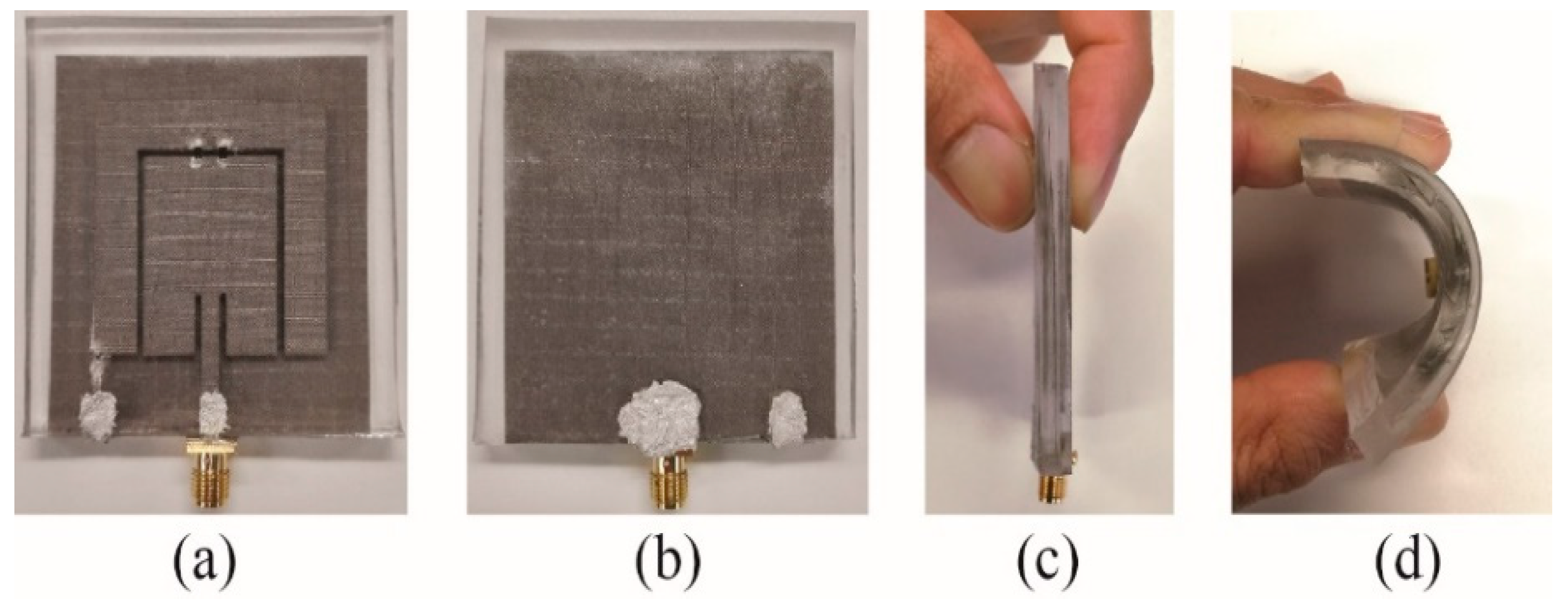
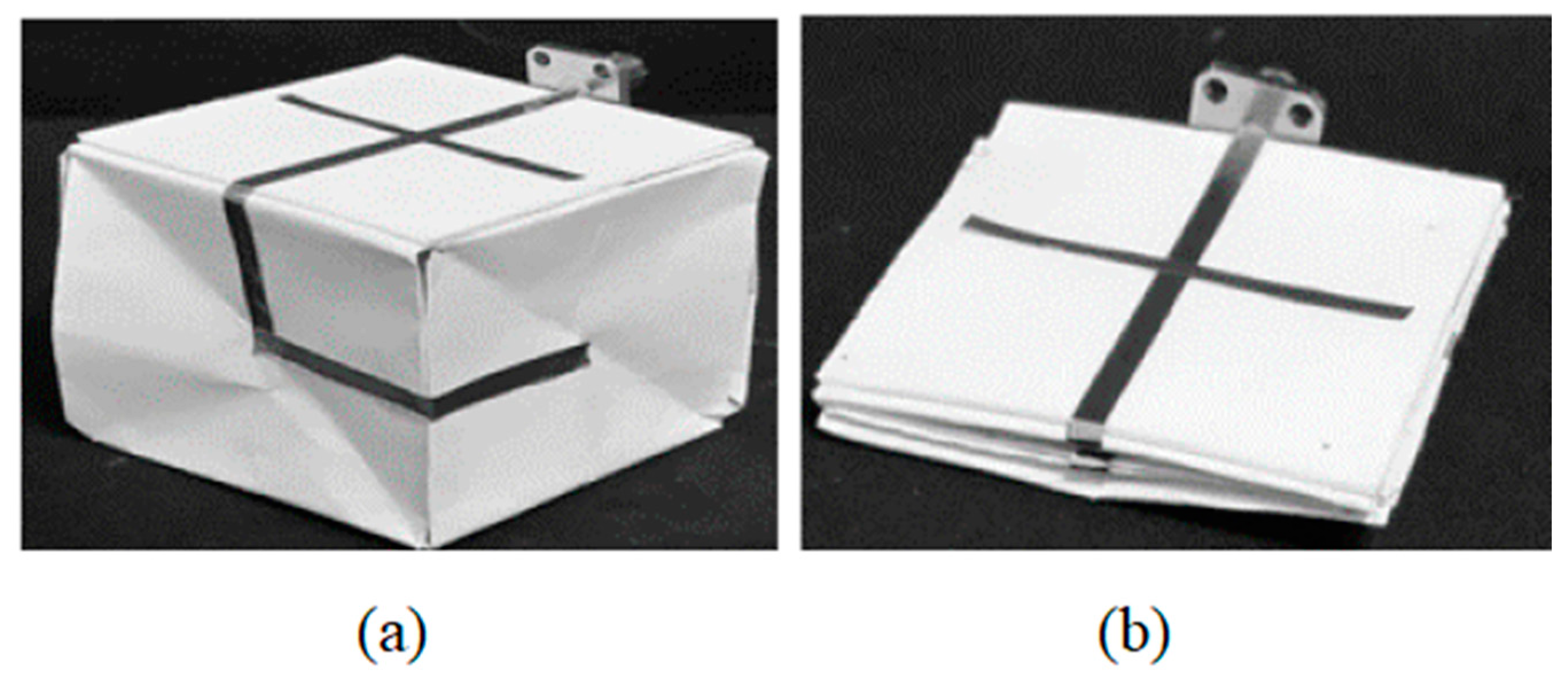
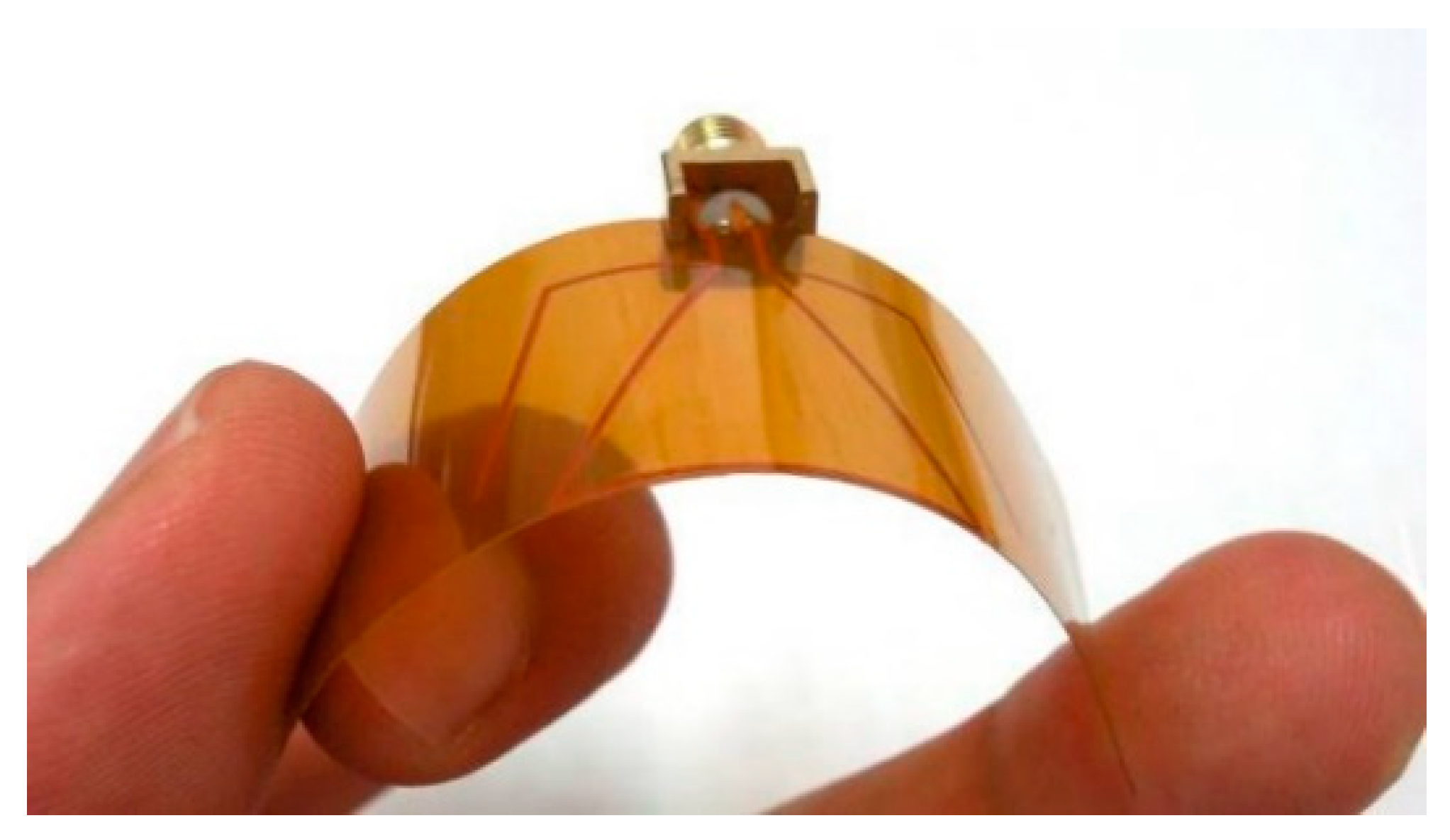

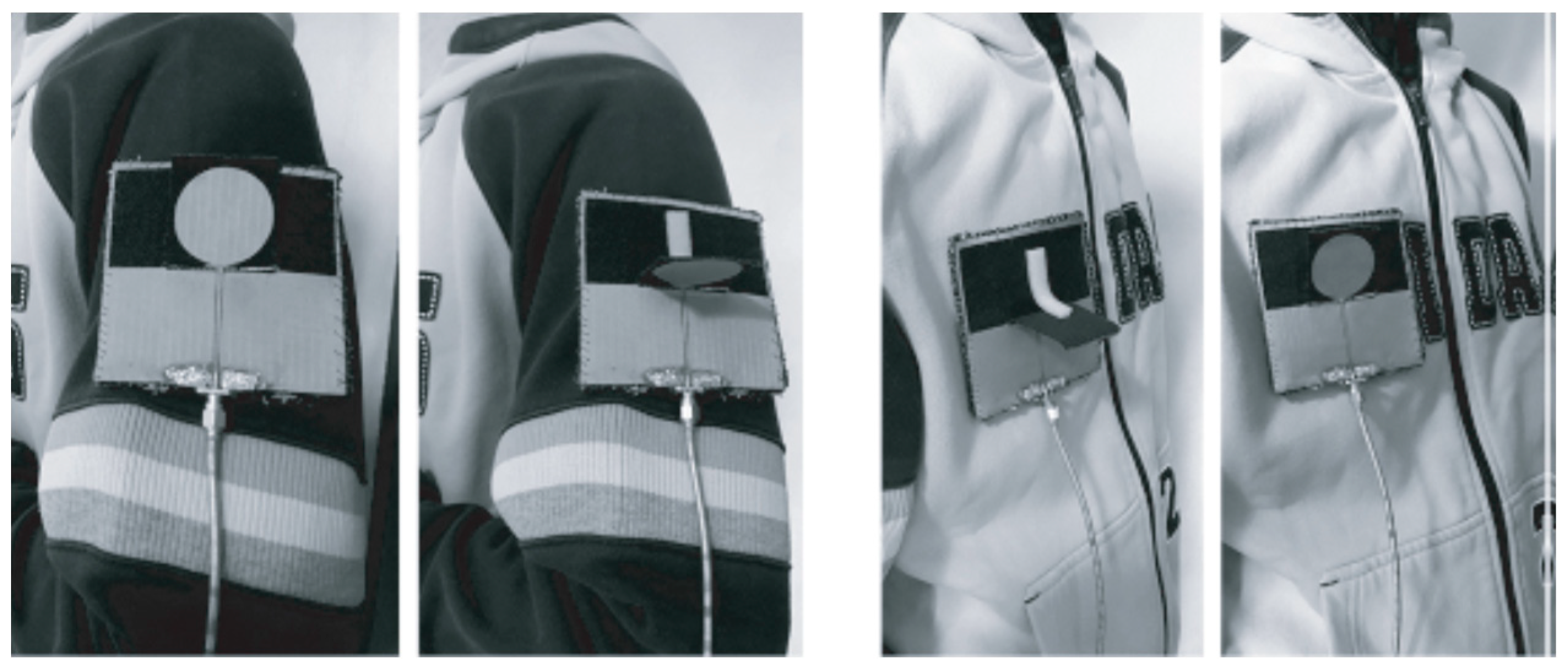

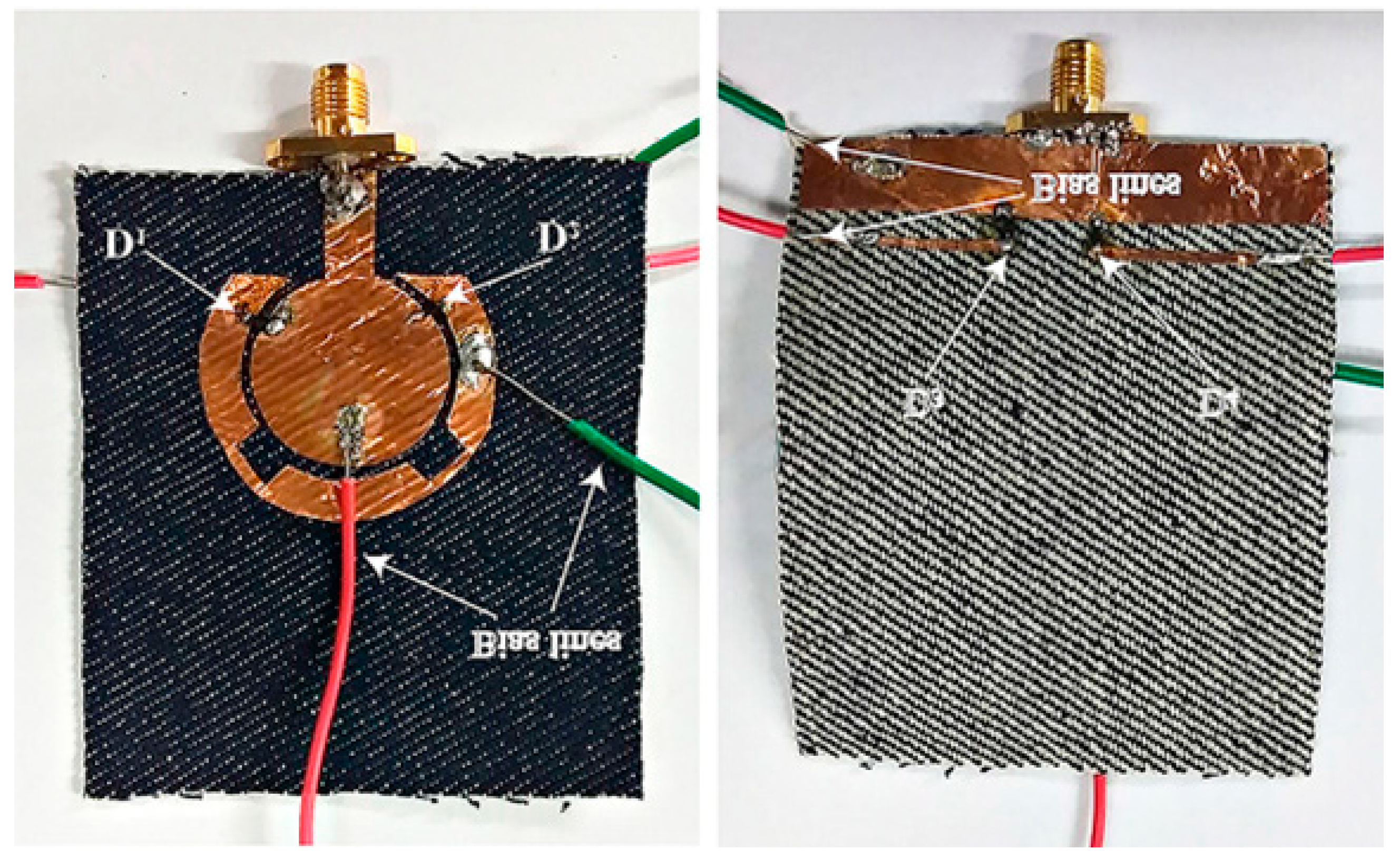
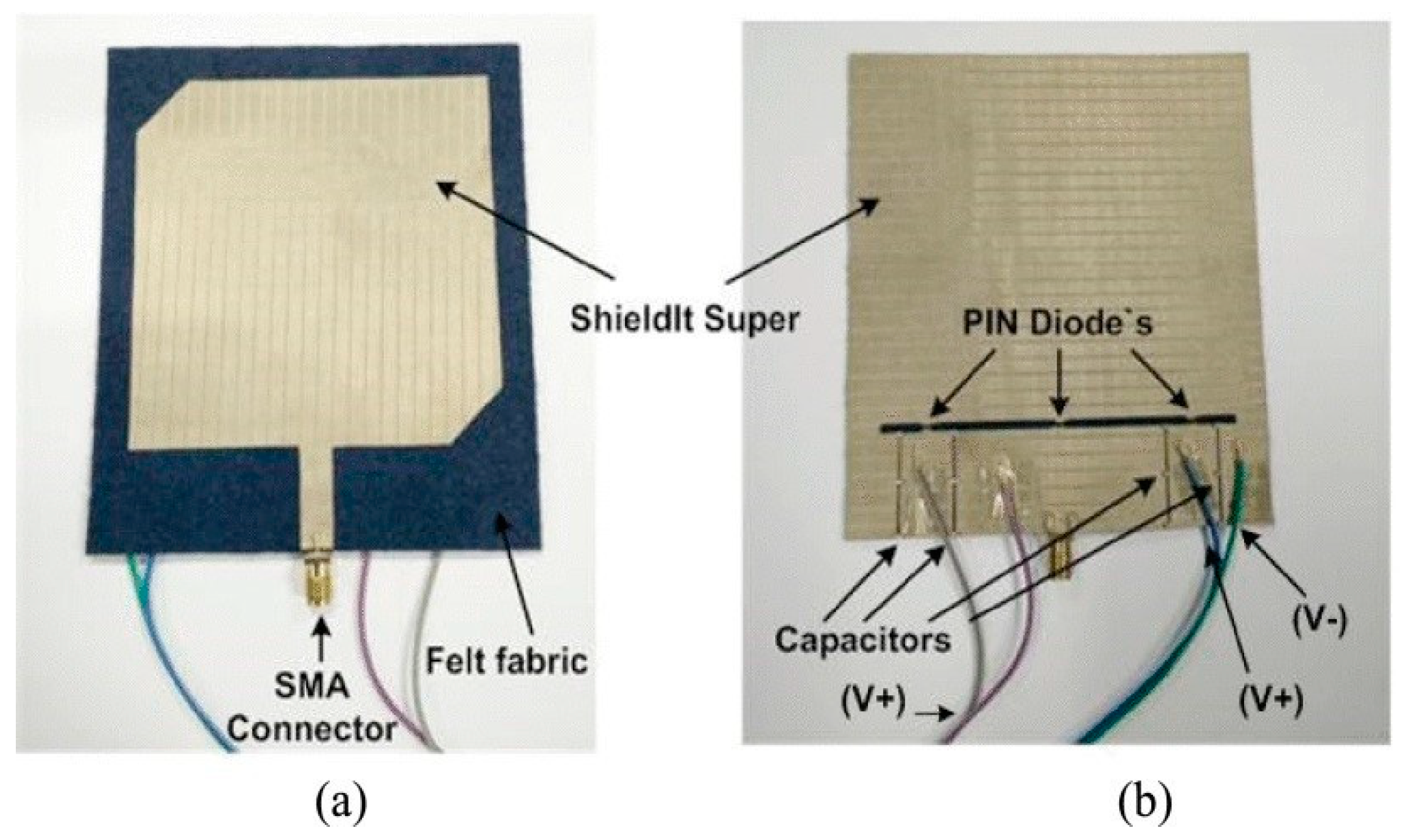
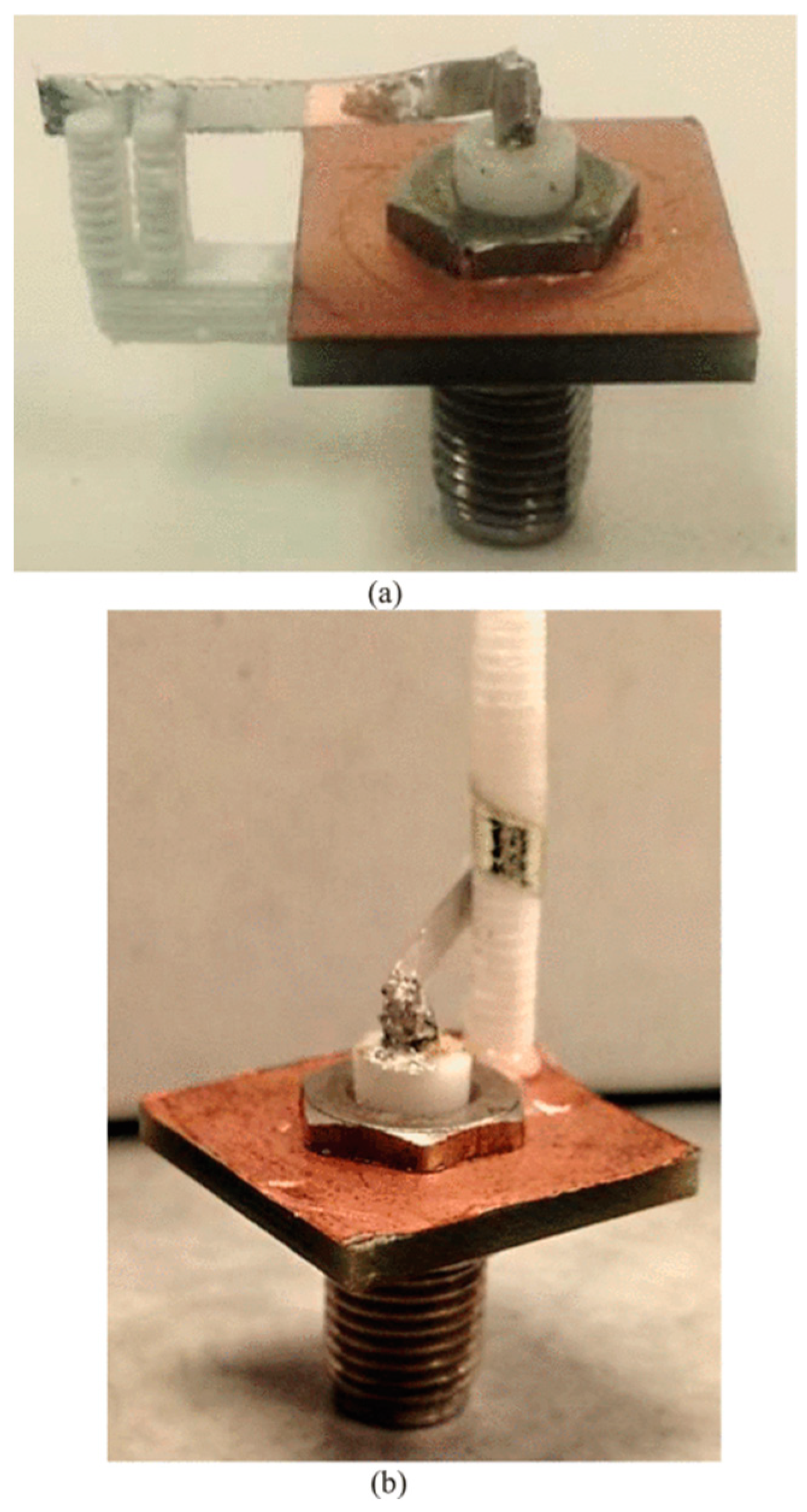
| Ref. | Antenna Type | Reconfigurability Method | No of States | Used Materials | Freq. (GHz) | Gain (dBi) | Eff. (%) | BW (%) | Height () | |||||
|---|---|---|---|---|---|---|---|---|---|---|---|---|---|---|
| Min. | Max. | Min. | Max. | Min. | Max. | Min. | Max. | |||||||
| [1] | patch | electrical switch/slot modification on ground | 6 | ShieldIt Super and Felt | 1.57 | 2.55 | 0.2 | 4.8 | 17 | 47 | 2.9 | 19 | 0.59 × 0.51 | 0.006 |
| [20] | patch | electrical switch/connecting two patches | 2 | copper tape, Denim | 2.45 | 5 | 3.17 | 3.55 | N/A | N/A | 2.5 | 5.85 | 0.40 × 0.19 | 0.008 |
| [21] | loop/monopole | electrical switch/geometry morphing | 3 | transparent PETP | 2.4 | 3.4 | 1.9 | 3.2 | 82.8 | 97 | 12.25 | 20.94 | 0.264 × 0.4 | 0.001 |
| [27] | dipole | physical/microfluidic based | 2 | S-glass, copper-tape, EGaIn | 3.84 | 5.34 | N/A | N/A | N/A | N/A | N/A | N/A | 1.8 × 1.8 | N/A |
| [24] | patch | electrical switch/parasitic patch | Continuous | Polymer, Conductive fabric | 2.3 | 2.68 | 2.9 | 3.3 | 40.3 | 46.1 | 0.3 | 0.4 | 0.4 × 0.43 | 0.042 |
| [28] | slot antenna | physical/change of permittivity by injection | 3 | FR4, PDMS, copper | 3.05 | 7.9 | N/A | N/A | N/A | N/A | N/A | N/A | N/A | 0.015 |
| [31] | helical | physical/height of structure | 3 | copper tape, sketching-paper | 0.86 | 3 | 4.69 | 6.79 | N/A | N/A | N/A | N/A | 0.13 × 0.13 | 0.07, 0.44, 0.78 |
| [32] | monopole/microstrip | physical/changing the type of antenna | 2 | copper-clad RT/duroid 5870 | 1.5 | 3.5 | N/A | N/A | N/A | N/A | 13.9 | 80 | N/A | N/A |
| [50] | Spring Antenna | physical/height of structure | 6 | Copper tape, paper | 1.1 | 1.4 | 9 | ~10 | N/A | N/A | N/A | N/A | N/A | 0.22 to 0.53 |
| [66] | patch | physical/based on injection alloys, reconfigurability by stretching up | Continuous | EGaIn, PDMS | 1.6 | 1.85 | N/A | N/A | N/A | N/A | 12.5 | 16.5 | 0.053 × 0.29 to 0.053 × 0.35 | 0.005 |
| Ref. | Antenna Type | Reconfigurability Method | No of States | Freq. (GHz) | Used Materials | Gain (dBi) | Eff. (%) | BW (%) | Height (λmin) | ||||
|---|---|---|---|---|---|---|---|---|---|---|---|---|---|
| Min. | Max. | Min. | Max. | Min. | Max. | ||||||||
| [81] | patch | electrical switch/connecting parasitic patches to the main patch | 4 | 2.45 | ShieldIt Super, Felt | N/A | N/A | N/A | N/A | N/A | N/A | 0.72 × 0.72 | 0.016 |
| [82] | monopole | electrical switch/connecting surrounding elements to the main patch | 2 | 2.40–2.48 | Rogers5880 | 0.5 | 0.7 | 77 | 78 | N/A | 3.2 | 0.28 × 0.2 | 0.001 |
| [85] | dipole, loop | electrical switch/combination of the pattern of two antennas | 3 | 2.47–2.53 | Polyimide | 1.96 | 2.48 | N/A | N/A | N/A | 2.4 | 0.2 × 0.35 | 0.004 |
| [86] | patch | electrical switch/connecting patch to the ground | 2 | 2.4 | Felt, conductive textile | 2 | 3.9 | 38 | 49.5 | 4.8 | 8.5 | 0.78 × 0.78 | 0.023 |
| [88] | patch | electrical switch/switching between feeding ports | 2 | 2.45 | felt and Copper Polyester Taffeta | 2.9 | 5.2 | 65 | 72 | 4.1 | 4.9 | 0.64 × 0.64 | 0.03 |
| [90] | array of dipoles | Physical/elongation of patch which is based on liquid metal | 3 | 12.5 | EGaIn, platinum-cured thermoset silicone | N/A | N/A | N/A | N/A | N/A | N/A | N/A | N/A |
| [91] | helical | Physical/folding and unfolding | 4 | 2.2 | copper film, PET | 7.5 | 9.5 | N/A | N/A | N/A | N/A | N/A | N/A |
| [92] | monopole | Physical/folding and unfolding origami reflectors | 8 | 2.4 | copper-clad FR4 substrate | 4.5 | 11 | 86 | 98 | 16 | 30 | 2.2 × 2.2 to 0.73 × 0.73 | ~0 to 0.73 |
| [93] | monopole | Physical/folding and unfolding two other directors on magic cube | 4 | 1.9 | copper film, paper | 1.9 | 7.3 | 64 | N/A | N/A | 21 | 0.24 × 0.24 | 0.06 to 0.72 |
| [95] | loop | Physical/magic cube origami | 3 | 1.39 | Copper tape, Kapton | 4.03 | 5.53 | 89 | 97 | 10 | 18 | 0.21 × 0.21 to 0.21 × 0.63 | 0.21 |
| Reconfiguration Element | Ref. | Material Name | Material Type | Dielectric Constant (Relative Permittivity) | Conductivity (S/m) or Resistivity (ohms/sq) | Suitable for Folding/Bending | Suitable for Sustained Folding/Bending | Freq. (GHz) | Gain (dBi) | Eff. (%) | BW (%) | Height | ||||||
|---|---|---|---|---|---|---|---|---|---|---|---|---|---|---|---|---|---|---|
| Min. | Max. | Min. | Max. | Min. | Max. | Min. | Max. | |||||||||||
| - | [1] | ShieldIt Super | Textile | - | - | 1.18 × 105 S/m | Yes | No | 1.57 | 2.55 | 0.2 | 4.8 | 17 | 47 | 2.9 | 15.4 | 0.59 × 0.51 | 0.006 |
| Felt | Textile | 1.22 | 0.016 | - | ||||||||||||||
| [17] | Graphene | Conductive Ink | - | - | 0.37 × 105 S/m | Yes | No | 3.03 | 6.13 | 0 | 2.09 | 54.9 | 74 | N/A | N/A | 0.46 × 0.54 | 0.015 | |
| Polyvinyl chloride foam, polyimide film | Polymer, Foam | 1.5,3.5 | - | - | ||||||||||||||
| [20] | Copper tape | Copper | - | - | - | Yes | No | 2.45 | 5 | 3.17 | 3.55 | N/A | N/A | 2.5 | 5.85 | 0.40 × 0.19 | 0.008 | |
| Denim | Fabric | 1.68 | 0.03 | - | ||||||||||||||
| [24] | a nylon ripstop fabric | Fabric | - | - | 0.01 Ω/sq | Yes | No | 2.3 | 2.68 | 2.9 | 3.3 | 40.3 | 46.1 | 0.3 | 0.4 | 0.4 × 0.43 | 0.042 | |
| PDMS | Polymer | 2.82 | 0.023 | - | ||||||||||||||
| [25] | Shieldex | Fabric | - | - | 0.009 Ω/sq | Yes | No | 2.1 | 6.2 | −0.9 | 8.8 | 30 | 90 | N/A | N/A | 0.42 × 0.42 | 0.04 | |
| C-Foam PF-4 | Foam | 1.06 | 0.0001 | - | ||||||||||||||
| Conductive fluid as a switch | [27] | EGaIn | Liquid Metal | - | - | 3.4 × 106 S/m | Yes | Yes | 3.84 | 5.34 | N/A | N/A | N/A | N/A | N/A | N/A | 1.8 × 1.8 | N/A |
| S-glass | Fibers & Textile | 3.4 | - | - | ||||||||||||||
| Microfluidic antenna-physical deformation | [66] | EGaIn | Liquid Metal | - | - | 3.4 × 104 S/m | Yes | Yes | 1.6 | 1.85 | N/A | N/A | N/A | N/A | 12.5 | 16.5 | 0.053 × 0.29 to 0.053 × 0.35 | 0.005 |
| PDMS | Polymer | 2.67 | 0.0375 | - | ||||||||||||||
| [67] | Galinstan | Liquid Metal | - | - | 3.46 × 106 S/m | Yes | Yes | 1.3 | 3 | N/A | N/A | 65 | 80 | N/A | N/A | 0.17 × 0.65 | 0.02 | |
| TC5005 | Silicone | 2.8–3.1 | - | - | ||||||||||||||
| [90] | EGaIn | Liquid Metal | - | - | 3.4 × 104 S/m | Yes | Yes | N/A | N/A | N/A | N/A | N/A | N/A | N/A | N/A | N/A | N/A | |
| Platinum-cured thermoset silicone | Polymer | 2.2 | 0.08 | - | ||||||||||||||
| Origami Based antenna-physical deformation | [37] | E-threads | Threads | - | - | 1.9 Ω/m | Yes | Yes | 0.76 | 1.015 | −2.5 | 0 | N/A | N/A | 12 | 14 | 0.42 × 0.025 | N/A |
| Organza | Fabric | (~1) | - | - | ||||||||||||||
| [74] | Copper film | Metal | - | 4.4 × 105 S/m | Yes | No | 0.9 | 2.5 | 1.1 | 3.28 | N/A | N/A | 14 | 20 | 0.15 × 0.15 | 0.0006 to 0.15 | ||
| Paper | Paper | 2.2 | 0.04 | - | ||||||||||||||
| [75] | Copper sheets | Metal | - | - | - | Yes | Yes | 0.95 | 1.6 | N/A | N/A | N/A | N/A | N/A | N/A | 0.44 × 0.12 | N/A | |
| Verowhite | Polymer | 2.8 | 0.01 | - | ||||||||||||||
| [92] | Copper | Metal | - | - | 5.96 × 105 S/m | Yes | Yes | 2.4 | 4.5 | 11 | 86 | 98 | 16 | 30 | 2.2 × 2.2 to 0.73 × 0.73 | ~0 to 0.73 | ||
| FR4 substrate | Composite | 4.4 | - | - | ||||||||||||||
© 2020 by the authors. Licensee MDPI, Basel, Switzerland. This article is an open access article distributed under the terms and conditions of the Creative Commons Attribution (CC BY) license (http://creativecommons.org/licenses/by/4.0/).
Share and Cite
Mohamadzade, B.; Simorangkir, R.B.V.B.; Maric, S.; Lalbakhsh, A.; Esselle, K.P.; Hashmi, R.M. Recent Developments and State of the Art in Flexible and Conformal Reconfigurable Antennas. Electronics 2020, 9, 1375. https://doi.org/10.3390/electronics9091375
Mohamadzade B, Simorangkir RBVB, Maric S, Lalbakhsh A, Esselle KP, Hashmi RM. Recent Developments and State of the Art in Flexible and Conformal Reconfigurable Antennas. Electronics. 2020; 9(9):1375. https://doi.org/10.3390/electronics9091375
Chicago/Turabian StyleMohamadzade, Bahare, Roy B. V. B. Simorangkir, Sasa Maric, Ali Lalbakhsh, Karu P. Esselle, and Raheel M. Hashmi. 2020. "Recent Developments and State of the Art in Flexible and Conformal Reconfigurable Antennas" Electronics 9, no. 9: 1375. https://doi.org/10.3390/electronics9091375
APA StyleMohamadzade, B., Simorangkir, R. B. V. B., Maric, S., Lalbakhsh, A., Esselle, K. P., & Hashmi, R. M. (2020). Recent Developments and State of the Art in Flexible and Conformal Reconfigurable Antennas. Electronics, 9(9), 1375. https://doi.org/10.3390/electronics9091375







